A Critical Analysis: The Role of Culture in Lean Management
VerifiedAdded on 2023/05/28
|9
|2074
|346
Essay
AI Summary
This essay provides a critical review of the relevant and irrelevant effects of societal culture on the success of lean management. It examines the influence of organizational culture, contrasting it with societal culture, and discusses the impact of lean practices on employees, highlighting both positive and negative outcomes. The analysis draws upon various studies and examples, including the Toyota Production System, to illustrate the complexities of implementing and sustaining lean processes in diverse cultural contexts. The essay explores how lean management can lead to improved efficiency and productivity but also acknowledges potential drawbacks such as increased stress and reduced job autonomy for workers. It concludes by emphasizing the importance of considering both organizational and societal factors to achieve successful and sustainable lean implementation.

CRITICAL REVIEW
Paraphrase This Document
Need a fresh take? Get an instant paraphrase of this document with our AI Paraphraser

Contents
Relevant effect of people`s societal culture on the success of lean........................................................2
Irrelevant effect of people`s societal culture on the success of lean.......................................................3
Positive effect of lean on people............................................................................................................6
References.............................................................................................................................................8
Relevant effect of people`s societal culture on the success of lean........................................................2
Irrelevant effect of people`s societal culture on the success of lean.......................................................3
Positive effect of lean on people............................................................................................................6
References.............................................................................................................................................8
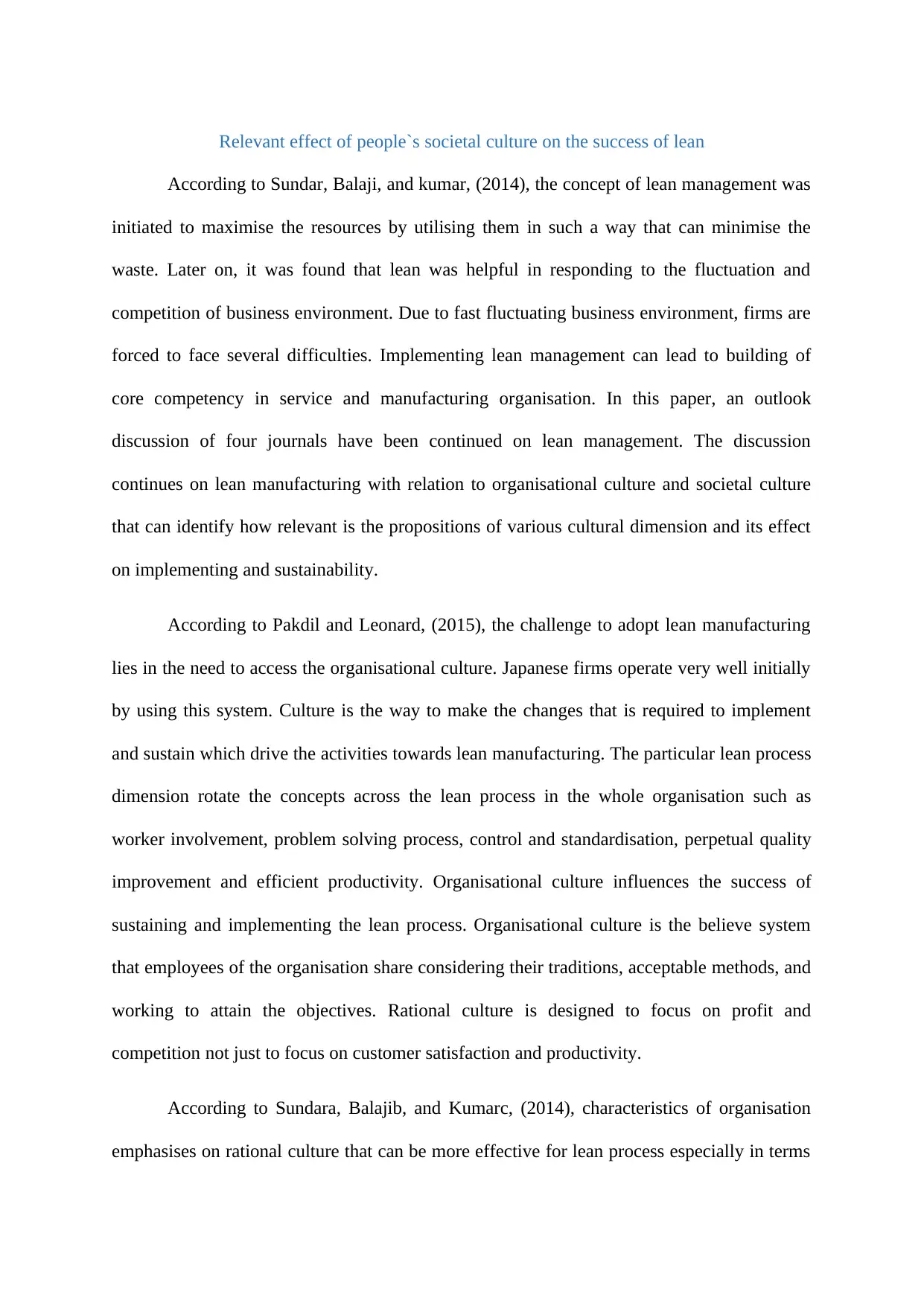
Relevant effect of people`s societal culture on the success of lean
According to Sundar, Balaji, and kumar, (2014), the concept of lean management was
initiated to maximise the resources by utilising them in such a way that can minimise the
waste. Later on, it was found that lean was helpful in responding to the fluctuation and
competition of business environment. Due to fast fluctuating business environment, firms are
forced to face several difficulties. Implementing lean management can lead to building of
core competency in service and manufacturing organisation. In this paper, an outlook
discussion of four journals have been continued on lean management. The discussion
continues on lean manufacturing with relation to organisational culture and societal culture
that can identify how relevant is the propositions of various cultural dimension and its effect
on implementing and sustainability.
According to Pakdil and Leonard, (2015), the challenge to adopt lean manufacturing
lies in the need to access the organisational culture. Japanese firms operate very well initially
by using this system. Culture is the way to make the changes that is required to implement
and sustain which drive the activities towards lean manufacturing. The particular lean process
dimension rotate the concepts across the lean process in the whole organisation such as
worker involvement, problem solving process, control and standardisation, perpetual quality
improvement and efficient productivity. Organisational culture influences the success of
sustaining and implementing the lean process. Organisational culture is the believe system
that employees of the organisation share considering their traditions, acceptable methods, and
working to attain the objectives. Rational culture is designed to focus on profit and
competition not just to focus on customer satisfaction and productivity.
According to Sundara, Balajib, and Kumarc, (2014), characteristics of organisation
emphasises on rational culture that can be more effective for lean process especially in terms
According to Sundar, Balaji, and kumar, (2014), the concept of lean management was
initiated to maximise the resources by utilising them in such a way that can minimise the
waste. Later on, it was found that lean was helpful in responding to the fluctuation and
competition of business environment. Due to fast fluctuating business environment, firms are
forced to face several difficulties. Implementing lean management can lead to building of
core competency in service and manufacturing organisation. In this paper, an outlook
discussion of four journals have been continued on lean management. The discussion
continues on lean manufacturing with relation to organisational culture and societal culture
that can identify how relevant is the propositions of various cultural dimension and its effect
on implementing and sustainability.
According to Pakdil and Leonard, (2015), the challenge to adopt lean manufacturing
lies in the need to access the organisational culture. Japanese firms operate very well initially
by using this system. Culture is the way to make the changes that is required to implement
and sustain which drive the activities towards lean manufacturing. The particular lean process
dimension rotate the concepts across the lean process in the whole organisation such as
worker involvement, problem solving process, control and standardisation, perpetual quality
improvement and efficient productivity. Organisational culture influences the success of
sustaining and implementing the lean process. Organisational culture is the believe system
that employees of the organisation share considering their traditions, acceptable methods, and
working to attain the objectives. Rational culture is designed to focus on profit and
competition not just to focus on customer satisfaction and productivity.
According to Sundara, Balajib, and Kumarc, (2014), characteristics of organisation
emphasises on rational culture that can be more effective for lean process especially in terms
⊘ This is a preview!⊘
Do you want full access?
Subscribe today to unlock all pages.

Trusted by 1+ million students worldwide
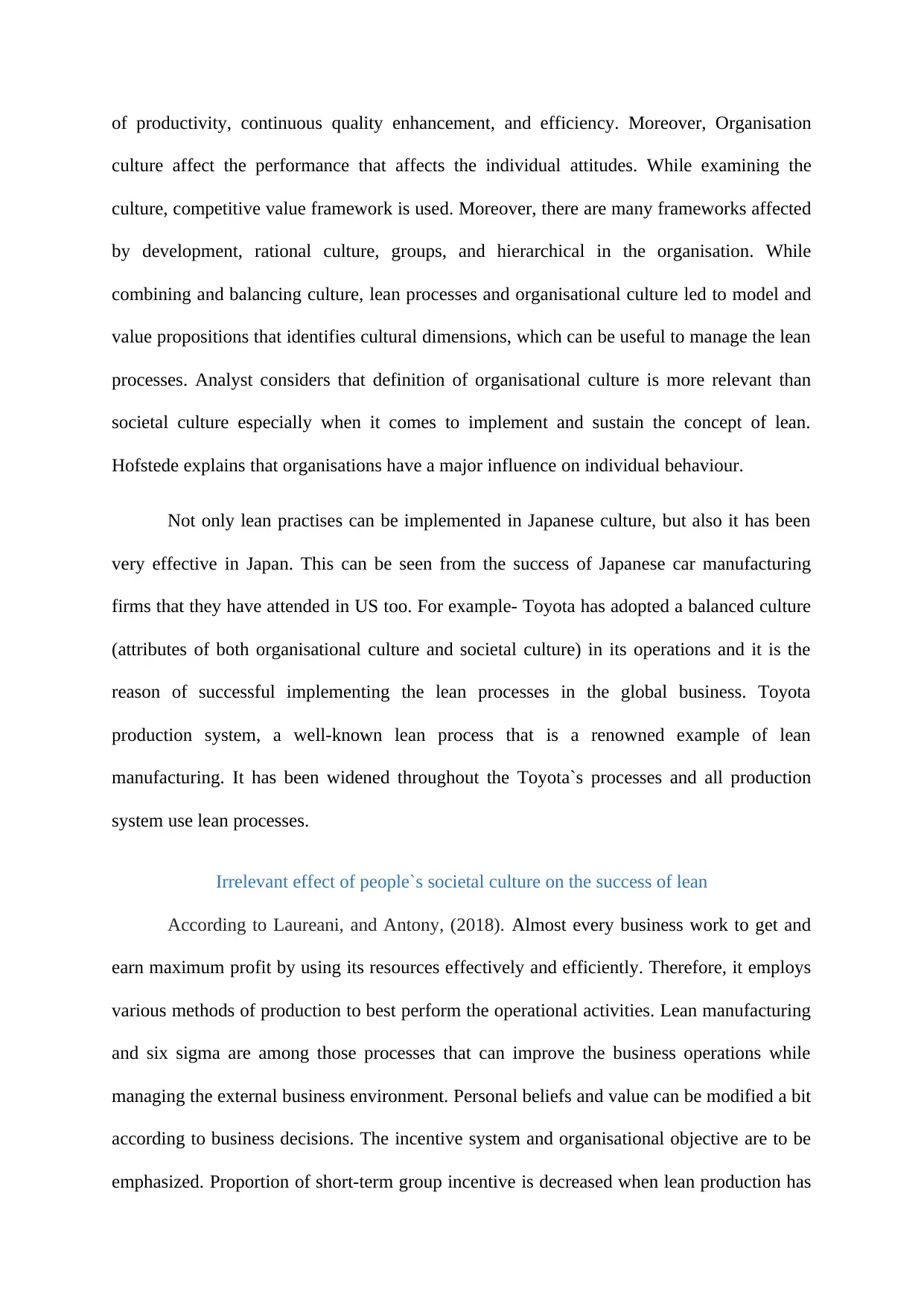
of productivity, continuous quality enhancement, and efficiency. Moreover, Organisation
culture affect the performance that affects the individual attitudes. While examining the
culture, competitive value framework is used. Moreover, there are many frameworks affected
by development, rational culture, groups, and hierarchical in the organisation. While
combining and balancing culture, lean processes and organisational culture led to model and
value propositions that identifies cultural dimensions, which can be useful to manage the lean
processes. Analyst considers that definition of organisational culture is more relevant than
societal culture especially when it comes to implement and sustain the concept of lean.
Hofstede explains that organisations have a major influence on individual behaviour.
Not only lean practises can be implemented in Japanese culture, but also it has been
very effective in Japan. This can be seen from the success of Japanese car manufacturing
firms that they have attended in US too. For example- Toyota has adopted a balanced culture
(attributes of both organisational culture and societal culture) in its operations and it is the
reason of successful implementing the lean processes in the global business. Toyota
production system, a well-known lean process that is a renowned example of lean
manufacturing. It has been widened throughout the Toyota`s processes and all production
system use lean processes.
Irrelevant effect of people`s societal culture on the success of lean
According to Laureani, and Antony, (2018). Almost every business work to get and
earn maximum profit by using its resources effectively and efficiently. Therefore, it employs
various methods of production to best perform the operational activities. Lean manufacturing
and six sigma are among those processes that can improve the business operations while
managing the external business environment. Personal beliefs and value can be modified a bit
according to business decisions. The incentive system and organisational objective are to be
emphasized. Proportion of short-term group incentive is decreased when lean production has
culture affect the performance that affects the individual attitudes. While examining the
culture, competitive value framework is used. Moreover, there are many frameworks affected
by development, rational culture, groups, and hierarchical in the organisation. While
combining and balancing culture, lean processes and organisational culture led to model and
value propositions that identifies cultural dimensions, which can be useful to manage the lean
processes. Analyst considers that definition of organisational culture is more relevant than
societal culture especially when it comes to implement and sustain the concept of lean.
Hofstede explains that organisations have a major influence on individual behaviour.
Not only lean practises can be implemented in Japanese culture, but also it has been
very effective in Japan. This can be seen from the success of Japanese car manufacturing
firms that they have attended in US too. For example- Toyota has adopted a balanced culture
(attributes of both organisational culture and societal culture) in its operations and it is the
reason of successful implementing the lean processes in the global business. Toyota
production system, a well-known lean process that is a renowned example of lean
manufacturing. It has been widened throughout the Toyota`s processes and all production
system use lean processes.
Irrelevant effect of people`s societal culture on the success of lean
According to Laureani, and Antony, (2018). Almost every business work to get and
earn maximum profit by using its resources effectively and efficiently. Therefore, it employs
various methods of production to best perform the operational activities. Lean manufacturing
and six sigma are among those processes that can improve the business operations while
managing the external business environment. Personal beliefs and value can be modified a bit
according to business decisions. The incentive system and organisational objective are to be
emphasized. Proportion of short-term group incentive is decreased when lean production has
Paraphrase This Document
Need a fresh take? Get an instant paraphrase of this document with our AI Paraphraser
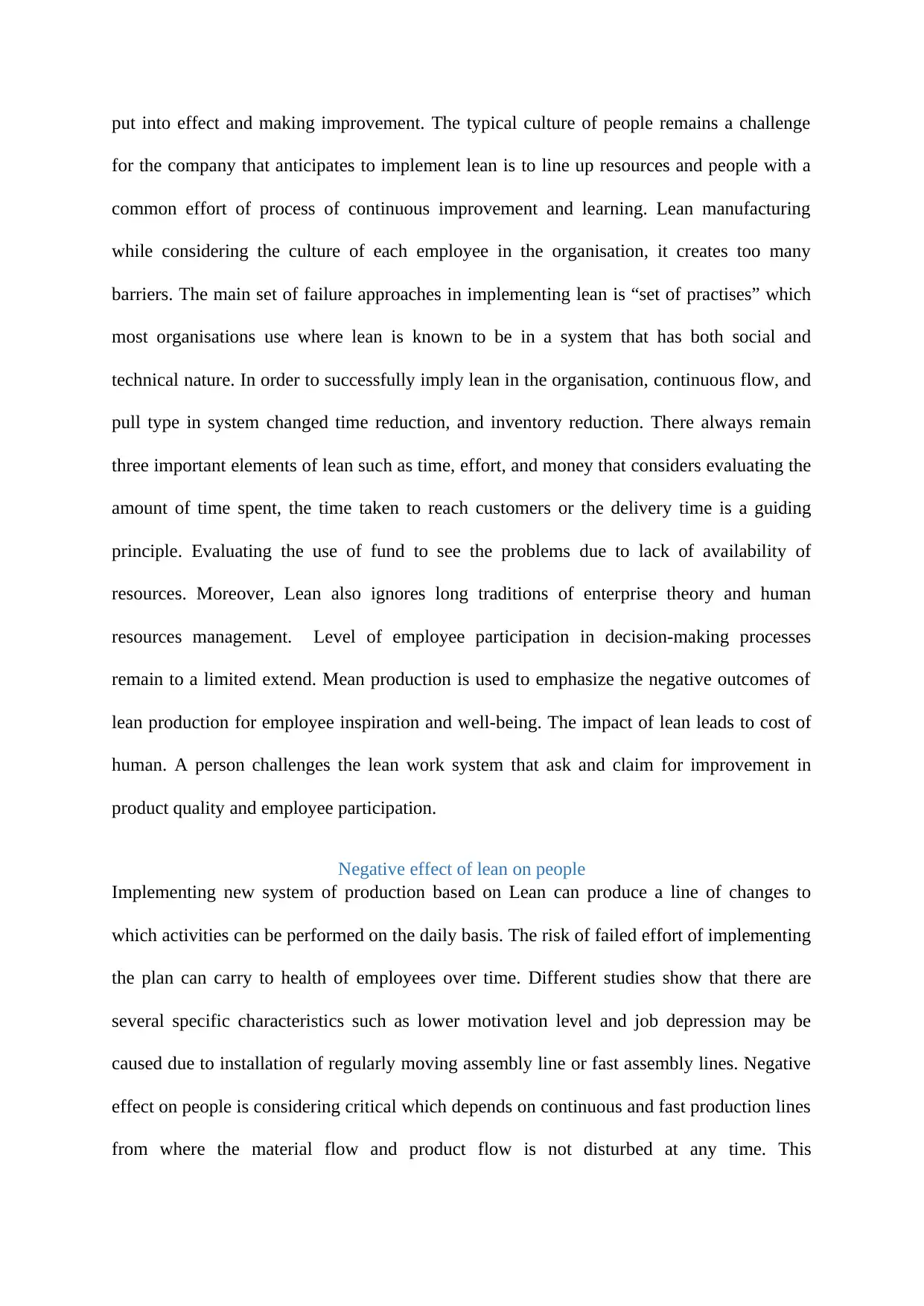
put into effect and making improvement. The typical culture of people remains a challenge
for the company that anticipates to implement lean is to line up resources and people with a
common effort of process of continuous improvement and learning. Lean manufacturing
while considering the culture of each employee in the organisation, it creates too many
barriers. The main set of failure approaches in implementing lean is “set of practises” which
most organisations use where lean is known to be in a system that has both social and
technical nature. In order to successfully imply lean in the organisation, continuous flow, and
pull type in system changed time reduction, and inventory reduction. There always remain
three important elements of lean such as time, effort, and money that considers evaluating the
amount of time spent, the time taken to reach customers or the delivery time is a guiding
principle. Evaluating the use of fund to see the problems due to lack of availability of
resources. Moreover, Lean also ignores long traditions of enterprise theory and human
resources management. Level of employee participation in decision-making processes
remain to a limited extend. Mean production is used to emphasize the negative outcomes of
lean production for employee inspiration and well-being. The impact of lean leads to cost of
human. A person challenges the lean work system that ask and claim for improvement in
product quality and employee participation.
Negative effect of lean on people
Implementing new system of production based on Lean can produce a line of changes to
which activities can be performed on the daily basis. The risk of failed effort of implementing
the plan can carry to health of employees over time. Different studies show that there are
several specific characteristics such as lower motivation level and job depression may be
caused due to installation of regularly moving assembly line or fast assembly lines. Negative
effect on people is considering critical which depends on continuous and fast production lines
from where the material flow and product flow is not disturbed at any time. This
for the company that anticipates to implement lean is to line up resources and people with a
common effort of process of continuous improvement and learning. Lean manufacturing
while considering the culture of each employee in the organisation, it creates too many
barriers. The main set of failure approaches in implementing lean is “set of practises” which
most organisations use where lean is known to be in a system that has both social and
technical nature. In order to successfully imply lean in the organisation, continuous flow, and
pull type in system changed time reduction, and inventory reduction. There always remain
three important elements of lean such as time, effort, and money that considers evaluating the
amount of time spent, the time taken to reach customers or the delivery time is a guiding
principle. Evaluating the use of fund to see the problems due to lack of availability of
resources. Moreover, Lean also ignores long traditions of enterprise theory and human
resources management. Level of employee participation in decision-making processes
remain to a limited extend. Mean production is used to emphasize the negative outcomes of
lean production for employee inspiration and well-being. The impact of lean leads to cost of
human. A person challenges the lean work system that ask and claim for improvement in
product quality and employee participation.
Negative effect of lean on people
Implementing new system of production based on Lean can produce a line of changes to
which activities can be performed on the daily basis. The risk of failed effort of implementing
the plan can carry to health of employees over time. Different studies show that there are
several specific characteristics such as lower motivation level and job depression may be
caused due to installation of regularly moving assembly line or fast assembly lines. Negative
effect on people is considering critical which depends on continuous and fast production lines
from where the material flow and product flow is not disturbed at any time. This
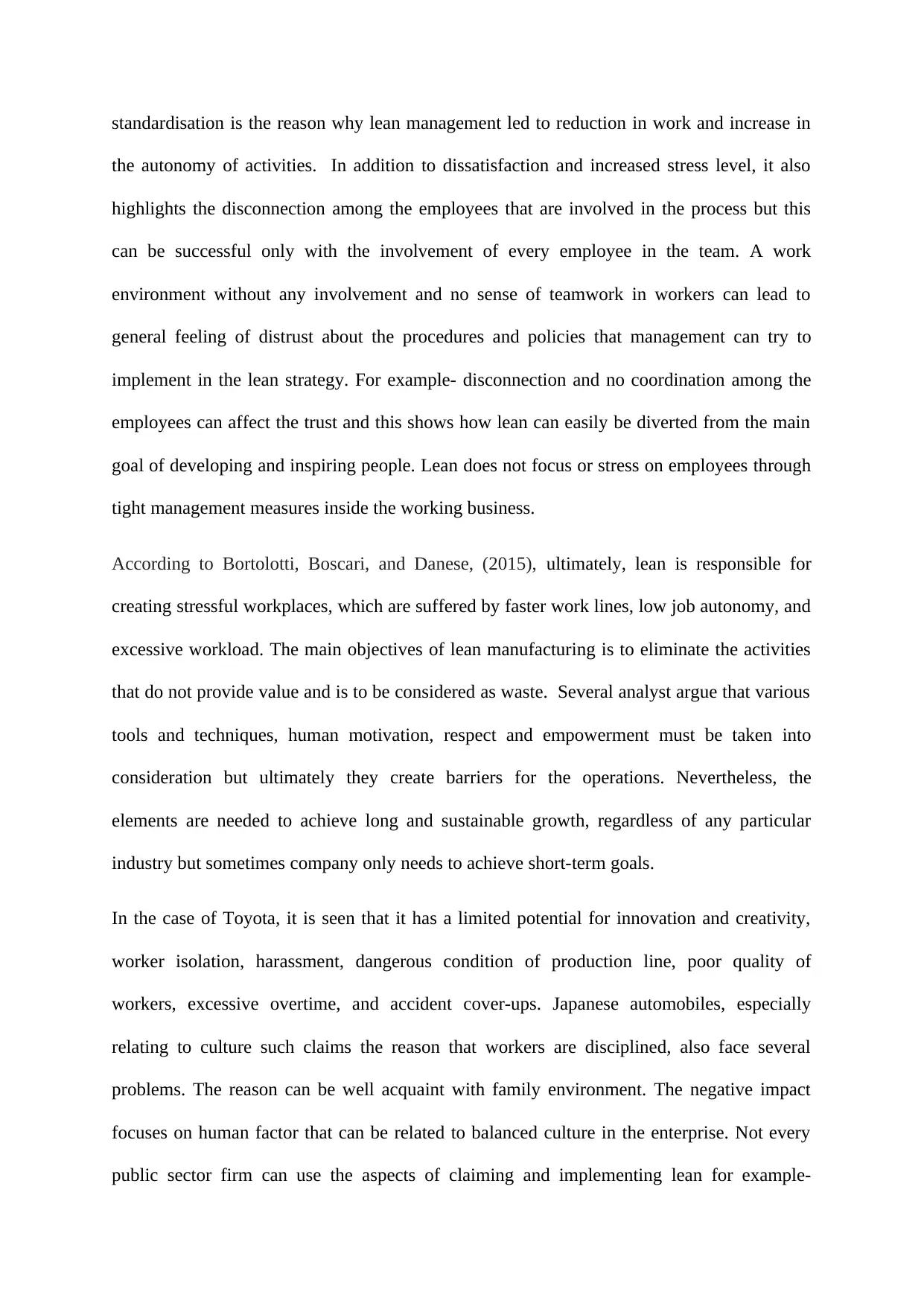
standardisation is the reason why lean management led to reduction in work and increase in
the autonomy of activities. In addition to dissatisfaction and increased stress level, it also
highlights the disconnection among the employees that are involved in the process but this
can be successful only with the involvement of every employee in the team. A work
environment without any involvement and no sense of teamwork in workers can lead to
general feeling of distrust about the procedures and policies that management can try to
implement in the lean strategy. For example- disconnection and no coordination among the
employees can affect the trust and this shows how lean can easily be diverted from the main
goal of developing and inspiring people. Lean does not focus or stress on employees through
tight management measures inside the working business.
According to Bortolotti, Boscari, and Danese, (2015), ultimately, lean is responsible for
creating stressful workplaces, which are suffered by faster work lines, low job autonomy, and
excessive workload. The main objectives of lean manufacturing is to eliminate the activities
that do not provide value and is to be considered as waste. Several analyst argue that various
tools and techniques, human motivation, respect and empowerment must be taken into
consideration but ultimately they create barriers for the operations. Nevertheless, the
elements are needed to achieve long and sustainable growth, regardless of any particular
industry but sometimes company only needs to achieve short-term goals.
In the case of Toyota, it is seen that it has a limited potential for innovation and creativity,
worker isolation, harassment, dangerous condition of production line, poor quality of
workers, excessive overtime, and accident cover-ups. Japanese automobiles, especially
relating to culture such claims the reason that workers are disciplined, also face several
problems. The reason can be well acquaint with family environment. The negative impact
focuses on human factor that can be related to balanced culture in the enterprise. Not every
public sector firm can use the aspects of claiming and implementing lean for example-
the autonomy of activities. In addition to dissatisfaction and increased stress level, it also
highlights the disconnection among the employees that are involved in the process but this
can be successful only with the involvement of every employee in the team. A work
environment without any involvement and no sense of teamwork in workers can lead to
general feeling of distrust about the procedures and policies that management can try to
implement in the lean strategy. For example- disconnection and no coordination among the
employees can affect the trust and this shows how lean can easily be diverted from the main
goal of developing and inspiring people. Lean does not focus or stress on employees through
tight management measures inside the working business.
According to Bortolotti, Boscari, and Danese, (2015), ultimately, lean is responsible for
creating stressful workplaces, which are suffered by faster work lines, low job autonomy, and
excessive workload. The main objectives of lean manufacturing is to eliminate the activities
that do not provide value and is to be considered as waste. Several analyst argue that various
tools and techniques, human motivation, respect and empowerment must be taken into
consideration but ultimately they create barriers for the operations. Nevertheless, the
elements are needed to achieve long and sustainable growth, regardless of any particular
industry but sometimes company only needs to achieve short-term goals.
In the case of Toyota, it is seen that it has a limited potential for innovation and creativity,
worker isolation, harassment, dangerous condition of production line, poor quality of
workers, excessive overtime, and accident cover-ups. Japanese automobiles, especially
relating to culture such claims the reason that workers are disciplined, also face several
problems. The reason can be well acquaint with family environment. The negative impact
focuses on human factor that can be related to balanced culture in the enterprise. Not every
public sector firm can use the aspects of claiming and implementing lean for example-
⊘ This is a preview!⊘
Do you want full access?
Subscribe today to unlock all pages.

Trusted by 1+ million students worldwide
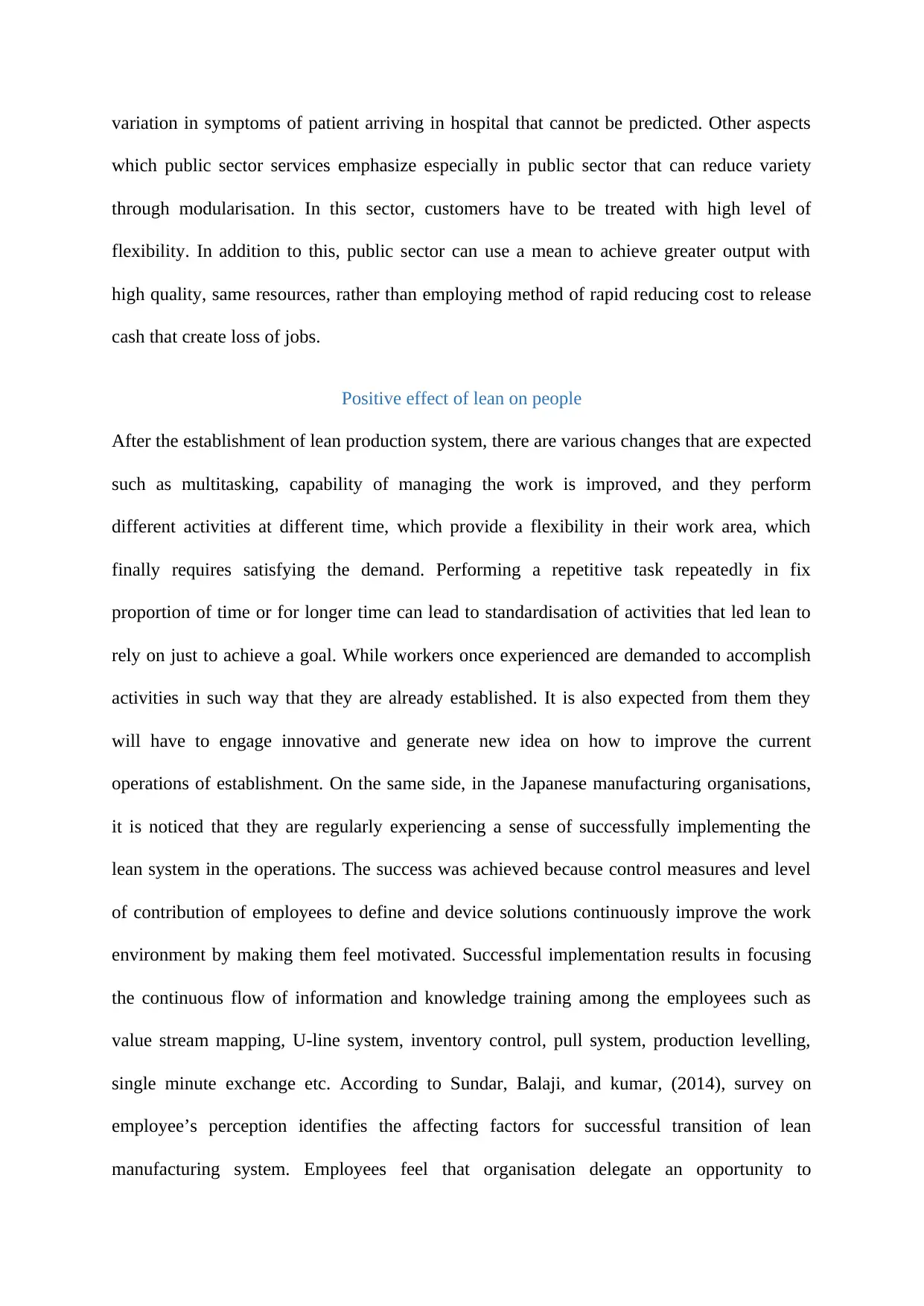
variation in symptoms of patient arriving in hospital that cannot be predicted. Other aspects
which public sector services emphasize especially in public sector that can reduce variety
through modularisation. In this sector, customers have to be treated with high level of
flexibility. In addition to this, public sector can use a mean to achieve greater output with
high quality, same resources, rather than employing method of rapid reducing cost to release
cash that create loss of jobs.
Positive effect of lean on people
After the establishment of lean production system, there are various changes that are expected
such as multitasking, capability of managing the work is improved, and they perform
different activities at different time, which provide a flexibility in their work area, which
finally requires satisfying the demand. Performing a repetitive task repeatedly in fix
proportion of time or for longer time can lead to standardisation of activities that led lean to
rely on just to achieve a goal. While workers once experienced are demanded to accomplish
activities in such way that they are already established. It is also expected from them they
will have to engage innovative and generate new idea on how to improve the current
operations of establishment. On the same side, in the Japanese manufacturing organisations,
it is noticed that they are regularly experiencing a sense of successfully implementing the
lean system in the operations. The success was achieved because control measures and level
of contribution of employees to define and device solutions continuously improve the work
environment by making them feel motivated. Successful implementation results in focusing
the continuous flow of information and knowledge training among the employees such as
value stream mapping, U-line system, inventory control, pull system, production levelling,
single minute exchange etc. According to Sundar, Balaji, and kumar, (2014), survey on
employee’s perception identifies the affecting factors for successful transition of lean
manufacturing system. Employees feel that organisation delegate an opportunity to
which public sector services emphasize especially in public sector that can reduce variety
through modularisation. In this sector, customers have to be treated with high level of
flexibility. In addition to this, public sector can use a mean to achieve greater output with
high quality, same resources, rather than employing method of rapid reducing cost to release
cash that create loss of jobs.
Positive effect of lean on people
After the establishment of lean production system, there are various changes that are expected
such as multitasking, capability of managing the work is improved, and they perform
different activities at different time, which provide a flexibility in their work area, which
finally requires satisfying the demand. Performing a repetitive task repeatedly in fix
proportion of time or for longer time can lead to standardisation of activities that led lean to
rely on just to achieve a goal. While workers once experienced are demanded to accomplish
activities in such way that they are already established. It is also expected from them they
will have to engage innovative and generate new idea on how to improve the current
operations of establishment. On the same side, in the Japanese manufacturing organisations,
it is noticed that they are regularly experiencing a sense of successfully implementing the
lean system in the operations. The success was achieved because control measures and level
of contribution of employees to define and device solutions continuously improve the work
environment by making them feel motivated. Successful implementation results in focusing
the continuous flow of information and knowledge training among the employees such as
value stream mapping, U-line system, inventory control, pull system, production levelling,
single minute exchange etc. According to Sundar, Balaji, and kumar, (2014), survey on
employee’s perception identifies the affecting factors for successful transition of lean
manufacturing system. Employees feel that organisation delegate an opportunity to
Paraphrase This Document
Need a fresh take? Get an instant paraphrase of this document with our AI Paraphraser
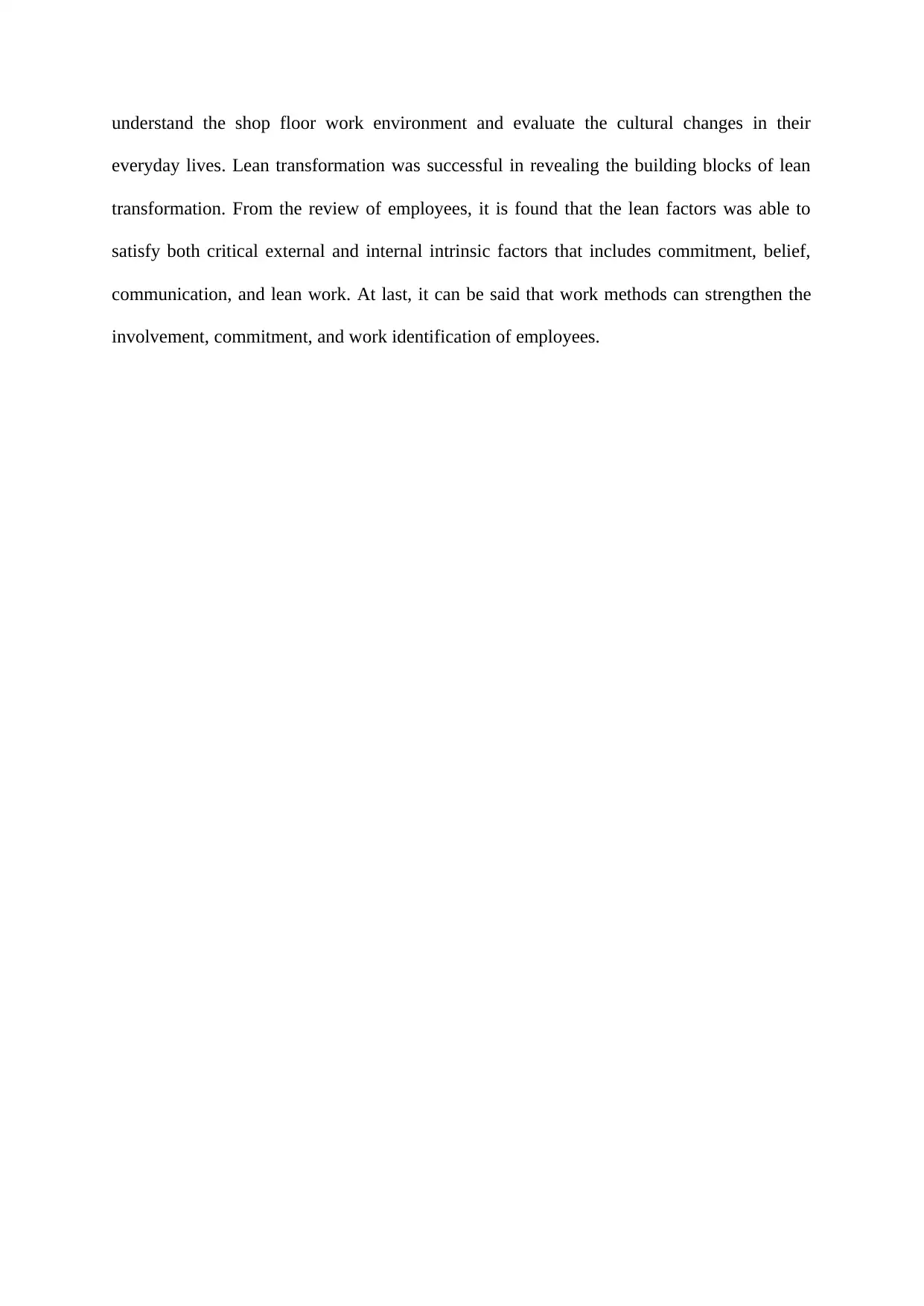
understand the shop floor work environment and evaluate the cultural changes in their
everyday lives. Lean transformation was successful in revealing the building blocks of lean
transformation. From the review of employees, it is found that the lean factors was able to
satisfy both critical external and internal intrinsic factors that includes commitment, belief,
communication, and lean work. At last, it can be said that work methods can strengthen the
involvement, commitment, and work identification of employees.
everyday lives. Lean transformation was successful in revealing the building blocks of lean
transformation. From the review of employees, it is found that the lean factors was able to
satisfy both critical external and internal intrinsic factors that includes commitment, belief,
communication, and lean work. At last, it can be said that work methods can strengthen the
involvement, commitment, and work identification of employees.
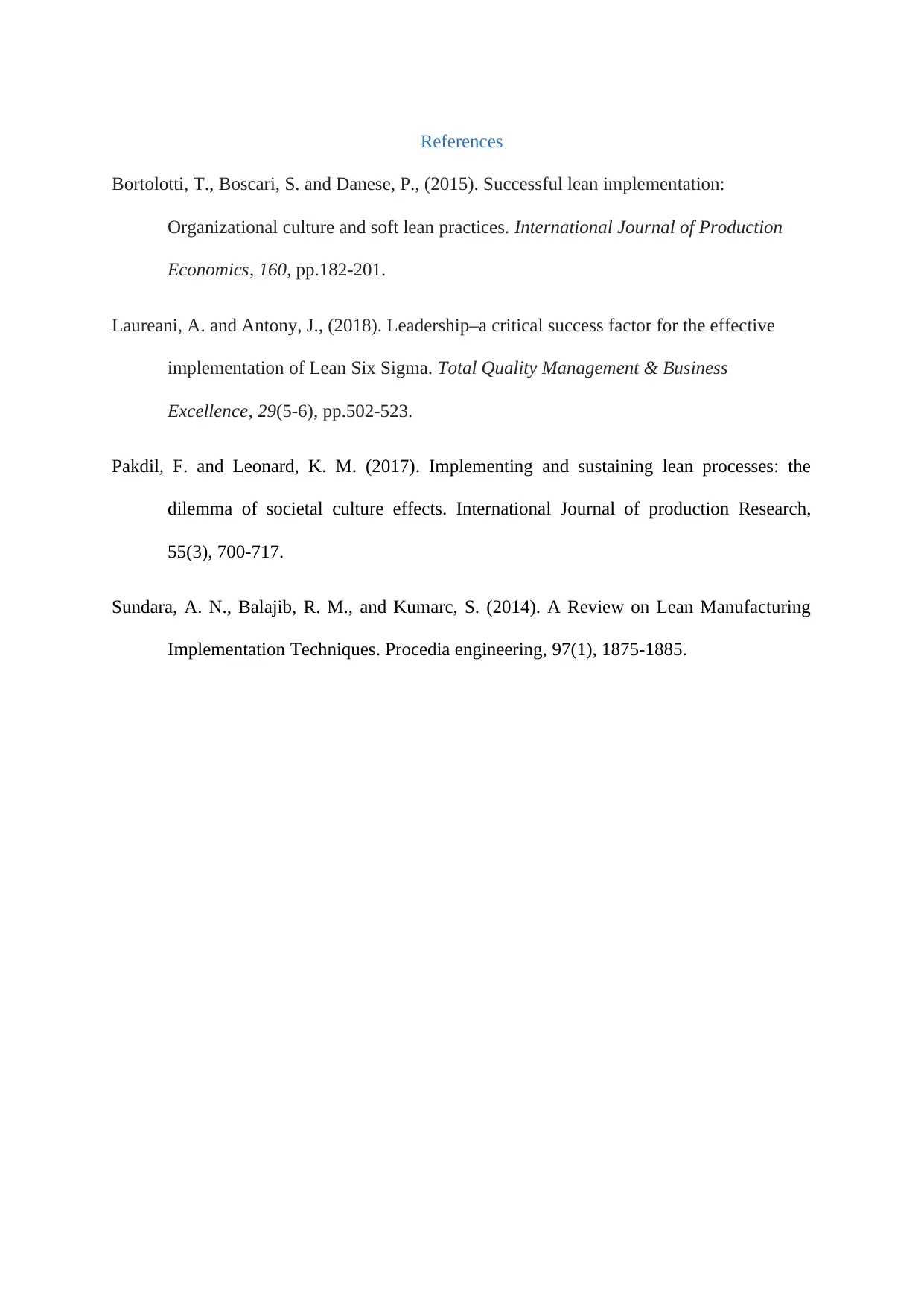
References
Bortolotti, T., Boscari, S. and Danese, P., (2015). Successful lean implementation:
Organizational culture and soft lean practices. International Journal of Production
Economics, 160, pp.182-201.
Laureani, A. and Antony, J., (2018). Leadership–a critical success factor for the effective
implementation of Lean Six Sigma. Total Quality Management & Business
Excellence, 29(5-6), pp.502-523.
Pakdil, F. and Leonard, K. M. (2017). Implementing and sustaining lean processes: the
dilemma of societal culture effects. International Journal of production Research,
55(3), 700-717.
Sundara, A. N., Balajib, R. M., and Kumarc, S. (2014). A Review on Lean Manufacturing
Implementation Techniques. Procedia engineering, 97(1), 1875-1885.
Bortolotti, T., Boscari, S. and Danese, P., (2015). Successful lean implementation:
Organizational culture and soft lean practices. International Journal of Production
Economics, 160, pp.182-201.
Laureani, A. and Antony, J., (2018). Leadership–a critical success factor for the effective
implementation of Lean Six Sigma. Total Quality Management & Business
Excellence, 29(5-6), pp.502-523.
Pakdil, F. and Leonard, K. M. (2017). Implementing and sustaining lean processes: the
dilemma of societal culture effects. International Journal of production Research,
55(3), 700-717.
Sundara, A. N., Balajib, R. M., and Kumarc, S. (2014). A Review on Lean Manufacturing
Implementation Techniques. Procedia engineering, 97(1), 1875-1885.
⊘ This is a preview!⊘
Do you want full access?
Subscribe today to unlock all pages.

Trusted by 1+ million students worldwide
1 out of 9
Related Documents
Your All-in-One AI-Powered Toolkit for Academic Success.
+13062052269
info@desklib.com
Available 24*7 on WhatsApp / Email
![[object Object]](/_next/static/media/star-bottom.7253800d.svg)
Unlock your academic potential
Copyright © 2020–2025 A2Z Services. All Rights Reserved. Developed and managed by ZUCOL.





